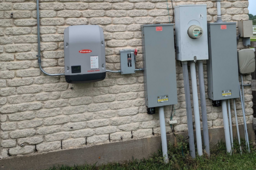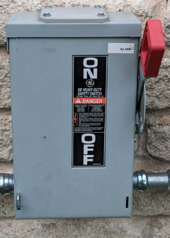willdeed
New Member
Hi folks,
I have a fairly new Fronius Primo 6kw inverter (attached images) that was installed about 4 months ago, and this is the third time it has shut off (no power output and nothing on the display). The first two times they replaced the fuses, so this seems to be a chronic problem.
I got a second opinion that said they installed it wrong and need to install a new switch to keep it from burning out fuses. He sounds like he knows what he's talking about, but after all the problems I've had, I don't know that I'm ready to pay $900 to find out it didn't actually solve the problem and is still burning out fuses.
My main reason for posting is that it seems like replacing the fuses is something I could do myself rather than having $200 truck rolls every few months. However, I have a healthy respect for electricity and want to make sure I understand exactly how all of this works before deciding if I'm comfortable with doing it myself.
At this point, I just want to take some initial pictures from inside the inverter, but I wasn't comfortable doing anything until I got some confirmation that I'm doing everything safely.
This is my initial plan:
1. Put on some rubber boots (any other PPE needed?)
2. Turn off the 2x30A breakers for the solar panels
3. Turn off the safety switch between the inverter and the breakers
4. turn off the DC shutoff switch on the inverter
5. Wait at least 30 minutes
6. Unscrew and swing out the inverter.
Any other safety precautions I can take other than wearing rubber boots?
A couple of related questions:
- I don't actually know where the fuses are, since Fronius documentation is sparse on this subject. Do I need to fully remove the inverter from the wall in order to take some pictures?
- From my understanding, the 2x30A breakers off disconnects the AC side from Mains and the DC shutoff switch on the bottom of the inverter shuts off the DC from the panels. The manual safety switch in between the two seems redundant (i.e. added protection if there's an issue with the breakers), but maybe I'm misunderstanding its role.
- The inverter is mounted on a southern-facing wall and I'm in southern Texas, so it gets hot. Could the heat be enough to burn the fuses when it's at peak output? There is about an hour or so of clipping in the early afternoon, so I'm guessing it's about 7kw worth of panels (I inherited the system from the previous owners and they didn't know).
TIA



I have a fairly new Fronius Primo 6kw inverter (attached images) that was installed about 4 months ago, and this is the third time it has shut off (no power output and nothing on the display). The first two times they replaced the fuses, so this seems to be a chronic problem.
I got a second opinion that said they installed it wrong and need to install a new switch to keep it from burning out fuses. He sounds like he knows what he's talking about, but after all the problems I've had, I don't know that I'm ready to pay $900 to find out it didn't actually solve the problem and is still burning out fuses.
My main reason for posting is that it seems like replacing the fuses is something I could do myself rather than having $200 truck rolls every few months. However, I have a healthy respect for electricity and want to make sure I understand exactly how all of this works before deciding if I'm comfortable with doing it myself.
At this point, I just want to take some initial pictures from inside the inverter, but I wasn't comfortable doing anything until I got some confirmation that I'm doing everything safely.
This is my initial plan:
1. Put on some rubber boots (any other PPE needed?)
2. Turn off the 2x30A breakers for the solar panels
3. Turn off the safety switch between the inverter and the breakers
4. turn off the DC shutoff switch on the inverter
5. Wait at least 30 minutes
6. Unscrew and swing out the inverter.
Any other safety precautions I can take other than wearing rubber boots?
A couple of related questions:
- I don't actually know where the fuses are, since Fronius documentation is sparse on this subject. Do I need to fully remove the inverter from the wall in order to take some pictures?
- From my understanding, the 2x30A breakers off disconnects the AC side from Mains and the DC shutoff switch on the bottom of the inverter shuts off the DC from the panels. The manual safety switch in between the two seems redundant (i.e. added protection if there's an issue with the breakers), but maybe I'm misunderstanding its role.
- The inverter is mounted on a southern-facing wall and I'm in southern Texas, so it gets hot. Could the heat be enough to burn the fuses when it's at peak output? There is about an hour or so of clipping in the early afternoon, so I'm guessing it's about 7kw worth of panels (I inherited the system from the previous owners and they didn't know).
TIA





